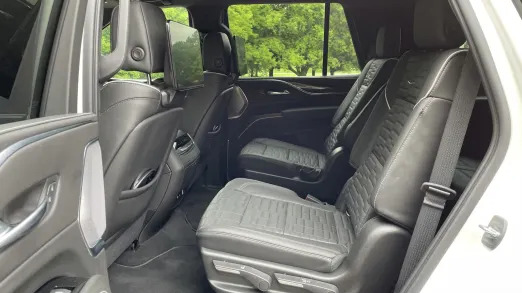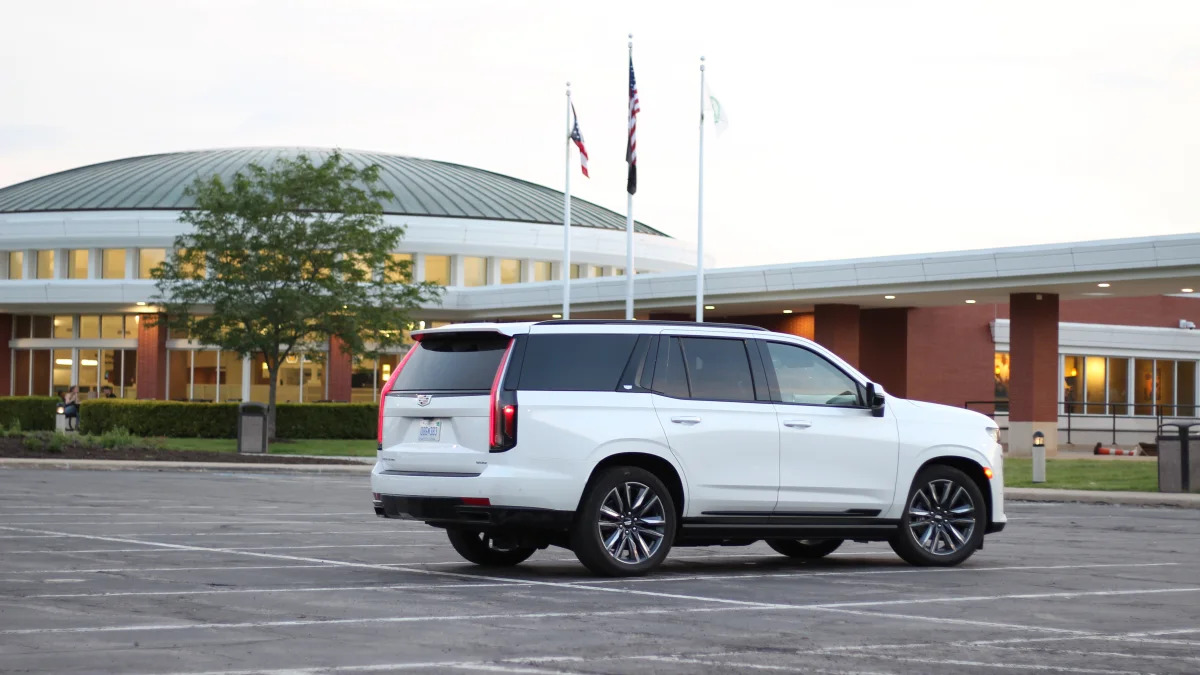There is no better road trip vehicle on sale today than a Super Cruise–equipped 2021 Cadillac Escalade. So long as you have the money to put fuel in it, the Escalade will reward you with the most relaxing and comfortable experience in the business.
It’s simple, really. Sitting back and not having to even worry about touching the steering wheel or pedals for hundreds of miles at a time does the trick. Every other driving-assistance system out there requires some degree of steering wheel interaction — even Tesla’s Autopilot — but Cadillac’s ingenious driver-monitoring system solves the problem.
You might be wondering why I’m writing a full review dedicated solely to Super Cruise. To answer your question, it’s because GM just rolled out its biggest update to the system ever. I also was planning to drive from Michigan to Buffalo, N.Y., which would put it through a lengthy highway test over a route that is almost entirely Super Cruise compatible — remember, Super Cruise only works on highways that GM has mapped with LiDAR technology.

Super Cruise launched in the Cadillac CT6, a model that is no longer in the Cadillac lineup. This updated, next-gen Super Cruise is rolling out in multiple new Cadillacs, as well as Chevys and soon GMC products, too. Its first home, though, is in the recently redesigned Cadillac Escalade, a perfect product to showcase the system’s impressive abilities.
So, what’s new? The big feature update is something called “Lane Change on Demand.” Just tap a turn signal stalk with the system activated, and the Escalade will change lanes all on its own. A little graphic pops up in the instrument cluster that says the car is “looking to make sure it’s safe.” It then begins to move over. Once it’s done, another graphic informs you that the lane change was successfully completed.
Moving over one lane takes about twice as long as a human driver would, but exercising caution with automation seems like a wise move. Changing lanes mid-curve works just fine on gentle turns. The Escalade will attempt to change lanes on tighter-radius curves, but it took more than 10 seconds to complete the change on a couple occasions, which just doesn’t feel safe or inspire confidence.
I did encounter one big issue with the auto lane-change system, but it was unrelated to the system’s performance. A “check right rear turn lamp” warning popped up about 100 miles into the trip. For the next 30 miles or so, every auto lane change to the right was auto-canceled by this warning. It would go left but not right due to the fault. After a while, the warning went away, and the system worked as normal. Chalk it up to just buggy electronics, as the right turn signal operated problem-free after that.

Cadillac improved the performance of the system’s radar sensors, too. The Escalade uses long-range radar in the front, short range radar in the front and rear, plus a front camera situated at the top of the windshield that helps determine lane lines. GM’s new electrical architecture made it possible to integrate and take advantage of these better sensors. Additionally, Cadillac gathered “richer map information” to make the car’s movements smoother in all situations.
The result is a stupendously good and reliable driving assistant. Turning the system on is foolproof. You can press the Super Cruise button on the steering wheel, then move the car into a proper lane position, and it activates right away. The steering wheel light bar illuminates in blue to tell you it’s searching for the lanes, then switches to green to let you know it’s on. All you need to do from here is keep your eyes on the road. Just like before, both a camera (on the column) and infrared emitters (in the steering wheel light bar) are watching and making sure that your eyes don’t stray elsewhere.
Look away for more than 4 or 5 seconds, and the Escalade will begin to squawk at you. Continue your disobedience for long enough, and it’ll shut down Super Cruise and lock you out as punishment. A simple power cycle is all that’s necessary to bring Super Cruise back after you’ve defied its demands like that.

My journey to Buffalo saw a few different highways, but mostly I-90. Just as Senior Editor for Green John Beltz Snyder experienced in a 2022 Chevy Bolt EUV, highway interchanges trip it up. Even if getting on a “new” highway only involves staying in your lane, the system will ask you to take control for a moment before letting you reactivate Super Cruise. It’s slightly annoying that the car can’t navigate these occurrences through integration of the in-car’s navigation system, but all that’s necessary is a quick button press, and you’re off again.
I spent hours-long stretches doing nothing but staring ahead, listening to podcasts and getting a massage from the Sport Platinum’s supportive seats. The ride delivered by GM’s incredible magnetic dampers is the pillowy support you want on a long drive. I was truly in road trip heaven.
With these highways mapped, I didn’t have to even think about correcting the car straying from its lane. However, there were a few occasions where I did take back control. The car is able to recognize when you’re in a construction zone, and it warns you upon noticing. Unlike human drivers who can make those small adjustments when one stray cone sits a little further out than others, Super Cruise doesn’t move around within its lane. I nudged the steering wheel every now and then when necessary. The other issue I ran into was lane placement relative to big rigs. Those drivers are not always the most disciplined with their lane keeping, and I had to move the Escalade out of harm’s way a number of times.




Being able to relax your arms and hands is the biggest reason for the Escalade’s road trip superiority, but there are others, too. The 36-speaker AKG system is audio paradise on wheels. Those headrest speakers might seem sort of gimmicky, too, but they really do add to the listening experience. If you just want quiet, the Escalade is good at shutting the world out, too. A whisper of wind rushing by the mirrors was the only intrusion.
I additionally enjoyed Cadillac’s augmented-reality navigation system that overlays directions onto a live video feed in the instrument cluster. It felt wrong to stare at the screen during an evening rainstorm I drove through, but looking at the display provided significantly better visibility than staring through a rainy and glare-affected windshield. Super Cruise worked without a hitch in the rain, but the real test will be a snowstorm when the radar and camera get covered in salt and road grime.
Fuel economy is the big downside to long road trips in an Escalade, although my test truck with the 6.2-liter V8 managed 20 mpg over the 350-mile road trip both ways (that's what Riswick managed over 900 miles in a Navigator). The Escalade’s requirement for premium fuel really made my wallet feel the pain, however. We maxed out a fuel pump (it literally cut off at $75, and I needed to insert my card to start back up) — but the relaxation of a Super Cruise-enhanced trip made it hurt less. Forking out the extra $2,500 for the option is worth it on any Cadillac, and the latest improvements make the system even more worthwhile.
Related video:











Sign in to post
Please sign in to leave a comment.
Continue